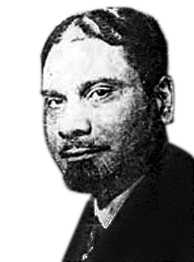
Dr. Chempakaraman Pillai: The freedom fighter who coined 'Jai Hind'
Dr.Chempakaraman Pillai was born in Thiruvananthapuram on 15 September 1891
.
While studying in Model School, he rallied against the British and shouted 'Jai Hind' on the school campus. Fearing retribution, the frightened principal called in the police. A constable, Chinnaswami Pillai, was sent to investigate the misdemeanor of the erring kid. It turned out that he was the son of Chinnaswami Pillai. Yes, His father was a police constable Chinnaswamy Pillai and his mother was Nagammal.
Once a British botanist, Sir Walter Strickland, was camping at Thiruvananthapuram and he had come to study butterflies that were found in the Western Ghats. Here, he met a boy who had presented a paper in a well-known science journal about the ability of spiders to change their color. Strickland was impressed by the skills of the 18-year boy, T. Padmanabha Pillai and took him to Europe for further studies. Along with him, his close friend and neighbor, Chempakaraman Pillai was also taken to Europe.
Raman Pillai continued his education in Austria and went on to complete his diploma in engineering. He also graduated in public governance and economics and had a grasp over 12 languages. He lived for 20 years in Germany working in German companies in various roles.
The Emden connection :
As per official records, Pillai was not aboard SMS Emden during the two months the ship was traversing the Indian Ocean. He was, as per records, involved in hectic parleys with politicians and like-minded revolutionaries. However, his wife has corroborated the assumption that Pillai had indeed alighted from SMS Emden at Kochi. With or without Pillai, the German ship must have received ample support from Indian revolutionaries.
After touching the British-Indian waters, SMS Emden had looked to depart via the Indonesian coast. Dr Douwes Dekker, an exiled freedom fighter, remembers that he had extended support to Raman Pillai to attack British India. Even the British Intelligence has gone on records saying that a 'prominent Indian revolutionary' had met the German ambassador to Switzerland to appraise him about the plans and strategies of Indian revolutionaries. Raman Pillai is also believed to have been close to the German emperor, according to ornithologist Salim Ali, who had mentioned his meeting with Pillai in Germany in his autobiography.
The plan to attack British India :
Pillai formed a group of international pro-Indians in Switzerland, which had taken a neutral stance during the First World War. A publication, ‘Pro India’, was also launched in German and English. He partnered with Virendranath Chattopadhyaya (Chatto), brother of Sarojini Naidu, for the endeavors. John Wellinger, who was in control of the British spy network in those times, is believed to have sent a team under his deputy, 'R,' to finish off the revolutionaries. Pillai and Chatto however escaped to Berlin. R turned out to be the famous novelist Somerset Maugham and he later created many characters in his novels based on the life of Indian revolutionaries.
In Berlin, Chatto and Pillai were in the company of many Indian revolutionaries operating under the Indian Independence League. Indians among them were novelist C.V. Raman Pillai's nephew A.R. Pillai; A.C. Nanu Nambiar, son of short-story writer, Vengayil Kunjiraman Nair; and T Padmanabha Pillai, whom Chempaka Raman Pillai had accompanied earlier to Europe. Chatto and Raman Pillai (Chempak) formed the Chatto-Chempak Berlin Committee. It received support from other revolutionaries. They decided to mobilize money and weapons on Indian shores.
With the aim of driving out the British and establishing a socialist democracy in India, Pillai travelled across Europe, Asia and German colonies in Africa, incognito. The German foreign office offered money and support and many revolutionaries including, Padmanabha Pillai, returned to India to direct the war against the British.
A vessel was arranged to drop off weapons at Java, which was the closest war-neutral region near India. It was agreed that a German war ship would drop off the weapons there. Narendranath Bhattacharya was sent to receive the weapons. However, the ship did not come and the plan did not materialize. Bhattacharya later went to Moscow, changed his name to M.N. Roy and formed the Indian Communist Party with his foreigner wife.
Raman Pillai wanted to attack British India from the north-western side of Kashmir. For that he sourced support from rebel forces in Turkey and highly placed officials under the Emir of Afghanistan. The Emir was however against providing any support while his close relatives and allies agreed to provide financial help for the movement.
On July 31, 1914, Raman Pillai formed the Indian National Voluntary Corps and urged war on British India. He called on all Indians, especially Muslims and Sikhs, to fight for India. He also sent emissaries to Japan and China to forge alliances. All these activities led to the notion that he was in SMS Emden when it struck Chennai.
Swami Vivekananda's brother, Bhupendranath Dutta, was sent to Russia to garner support for the cause. Two members were also sent to talk to US leaders. Pillai started a military camp in Mesopotamia and formed a provisional government in Kabul to look after Indian affairs when revolution would start. Raman Pillai was to handle foreign affairs of the new government.
However, all the grand plans came to nought when Germany was defeated in World War 1. In 1919, Pillai went to Germany. The Russian revolution that happened two years earlier saw many leaders, including Chatto, leaving for Russia. Chatto was later unceremoniously executed by Stalin's army. M.N. Roy quit Marxism, pained at the cruelty perpetuated by Stalin.
Raman Pillai continued to work in a German company, but kept his efforts for Indian independence alive. He directed an exhibition of Indian products in Germany in 1924. In 1930, he became the Berlin representative of the Indian Chamber of Commerce. He was the only non-white in the National People’s Party that supported the Nazis.
The squabble with Hitler :
Raman Pillai initially enjoyed a cordial relationship with Hitler, whose prominence was rising. However, during a press meet on August 10, 1931, Hitler said that if non-Aryan Indians were ruled by the British, it is their fate. This irritated Pillai. The same year on December 4, Hitler said, "Britain losing India would not augur well for any nation, including Germany."
Miffed at Hitler taking sides with the British, Raman Pillai wrote to him thus, "You seem to attribute more importance to the color of the skin than blood. Our skins may be dark; not our hearts."
Raman Pillai gave a deadline for Hitler to withdraw his statement and apologize. Hitler sent his secretary to Pillai to apologize, but also expressed his irritation at being attributed with a black heart. Raman Pillai retorted that Indians would tell the truth even in the face of death. One day after the deadline set by Pillai, Hitler expressed his regret for his comments; the rift between the two leaders thus developed into a complete breakdown of relations that would never be mended. In January 1933, Hitler became chancellor and in June he became an autocrat usurping power and establishing his unquestioned influence over Germany.
Nazis soon raided and arrogated Pillai’s house in Berlin. He was also manhandled and bundled out from his dwelling. He moved to Italy for treatment where it was found that blood had clotted in his brain. By that time, he did not have the financial means to afford good treatment required for his cure. His end came on May 28, 1934, in an ordinary nursing home in Italy. His wife lamented that a man who was brave enough to defy Hitler in his own land had died, unceremoniously, a broken man.
A patriot forgotten :
A statue of Chempakaraman Pillai at the Gandhi Mandapam Campus in Chennai was unveiled years ago
In his autobiography, Bhagat Singh's uncle and freedom fighter Sardar Ajith Singh had written that when Subhash Chandra Bose visited Vienna, he had visited Raman Pillai. Chempakaraman Pillai was instrumental in inspiring Netaji to start an army and had even founded the INV before the INA was formed. However, nothing remains as a token of respect to that patriot in his own motherland. There is a statue of Netaji at Thiruvananthapuram near University Stadium. The 'Jai Hind' inscribed on the statue, a term coined by Raman Pillai, is all that remains that may remind us of this man who died for his nation. The clarion call that inspired many to take up arms against the British now ironically echoes the level of ingratitude his own people have for him.
Reference: https://www.onmanorama.com/lifestyle/news/chempaka-raman-pillai-indian-revolutionary-freedom-fighter.html

Comments
No comments yet. Be the first to comment!